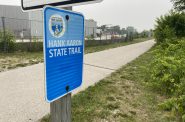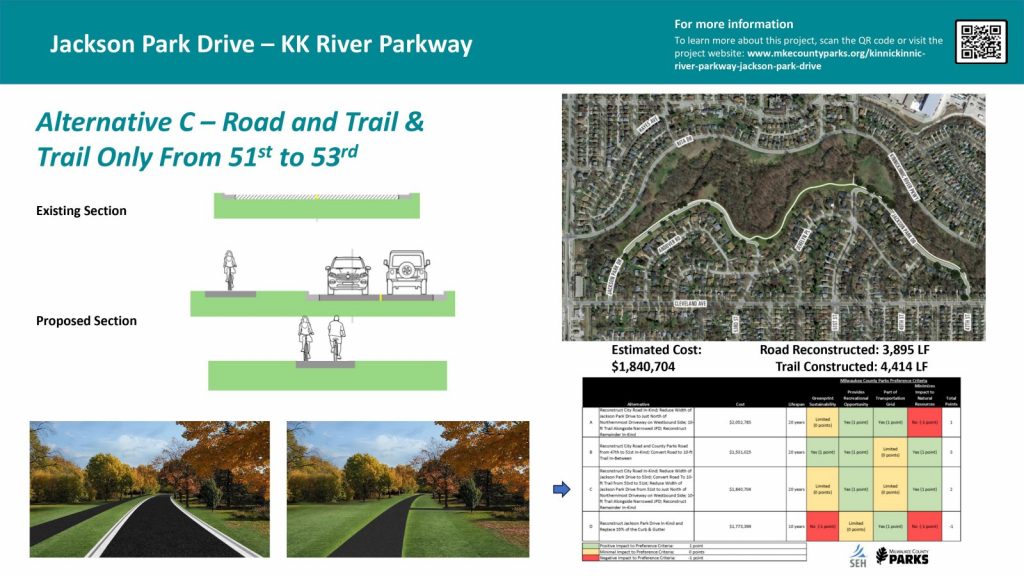Parks Committee Backs Jackson Park Trail ‘Compromise’
Parks committee backs plan to downsize trail conversion along Jackson Park Drive.
An attempt at a compromise that actually cuts back most of a proposed roadway-to-trail conversion may get the backing of the Milwaukee County Board.
Milwaukee County Parks is planning a conversion of less than one mile of Jackson Park Drive, running through the Kinnickinnic River Parkway, to a mixed-use trail. However, the project is facing pushback from some residents in the Jackson Park neighborhood, with many wanting to keep the roadway.
The road needs to be rebuilt in any case. It was last reconstructed in the 1980s, and is in terrible condition and becoming a safety issue, according to parks.
Parks proposes converting the roadway to a trail from roughly 51st to 58th Street. The trail would not cut off driveway access to the roadway for any homes, though some homes have front doors that face Jackson Park Drive.
The project would save the county money in the near and short term, as trails are less expensive to build and maintain than roads. It would also check several boxes for county policy goals related to health and environmental protection, as trails are safer and healthier than roads, produce less polluted stormwater runoff and aren’t associated with combustion vehicle emissions.
The two local supervisors, Peter Burgelis and Juan Miguel Martinez, worked with Parks to develop a third option that still converts some roadway to trail, albeit a smaller section. It would only convert a section of the parkway with backyards facing the road, roughly between S. 51st and S. 53rd streets. Because it would maintain more of the original roadway it comes at a higher price tag than Parks’ original conversion project.
A handful of residents spoke at a meeting of the board’s Committee on Parks and Culture Tuesday, expressing opposition to both the original conversion and the compromise plan. Burgelis noted this, saying, “And, frankly, this was brought forward as a compromise, and with a compromise not everyone gets everything that they want.”
The supervisors recognize that their compromise solution will cost taxpayers more upfront and in long-term maintenance costs, but are placing a premium on the desires of the residents who live near the roadway. “I frankly can’t understand why the parks department has been adamant on [the original plan], taking the roadway away from these people’s homes,” Burgelis said.
The Parks Committee unanimously voted in favor of Burgelis and Martinez “compromise plan,” with Supervisors Steven Shea, Steve Taylor, Sheldon Wasserman, Felesia Martin and Martinez voting for it. Parks estimates the compromise option will cost the county approximately $1,804,704. The cost estimate for the original plan was $1,531,025.
Parks does not support the compromise option and planned to pursue detailed design of the original trail conversion project.
However, the board has a history of derailing projects to the detriment of taxpayers and Parks has no illusions that the road-to-trail conversion will survive the county board intact.
“But if we were to dilute our recommendation, and then it gets further diluted through a political process, then we wouldn’t have an outcome that supports our goals,” said Deputy Director James Tarantino.
The county has a $1 billion backlog of infrastructure and maintenance needs. The parks system accounts for approximately 50% of it. And with more than 60 miles of roadways and 142 acres of parking lots, the Parks system spends a significant chunk of its infrastructure funding on roads and parking lots. In 2023, 50% of the budget for maintenance went to roads and parking lots, Tarantino said, which was far more than it spent on playgrounds, trails and athletic fields combined. In light of this reality, and the limited funding available, the department prioritizes reducing the paved footprint wherever possible.
“We are expected to provide 60 plus miles of roadway without dedicated funding or the tools available to a transportation department to fund those things,” Tarantino said.
Compared to the other options for the project, the original plan for converting the roadway to a trail better meets the county’s own policy positions on the rights of nature, climate and health equity. “In our opinion, in our analysis, this is the option that best aligns with all of the policy directives and goals that the county has given to our department,” Tarantino said.
For some nearby residents, however, the main consideration is maintaining their neighborhood as it currently exists. One resident, John Shaw, told the committee his family purchased their home in part because of the “scenic parkway setting,” and that they run and bike on the parkway, and that he enjoys using it for his drive to and from work. Shaw also echoed concerns about crime and homeless people living in the nearby woods that have become common in the debate over the project.
“A bike trail would reduce both police access and civilian traffic along the full length of the parkway,” Shaw said. “Both of which I feel help deter illegal activity in the area.”
Many of the other residents echoed Shaw’s general sentiments, including concerns about safety and enjoying the roadway. Others expressed concerns about their property values and losing the additional road access to their properties.
Two county residents who don’t live in the neighborhood spoke in favor of Parks’ original plan to convert the trail. Anna Bailliekova urged supervisors to consider the short and long-term cost of maintaining the roadway.
“I’d also encourage you to think about all of the stakeholders here,” Bailliekova said. “The residents here feel like they’re losing something, but you’ll never hear from all the people who live by a park that doesn’t get remodeled or all the capital improvements that we don’t make because we continue to sink our funds into impervious surfaces, like maintaining our roadways.”
If you think stories like this are important, become a member of Urban Milwaukee and help support real, independent journalism. Plus you get some cool added benefits.
Political Contributions Tracker
Displaying political contributions between people mentioned in this story. Learn more.
MKE County
-
Ron Johnson Says Free-Market Principles Could Fix Education
 Jul 17th, 2024 by Graham Kilmer
Jul 17th, 2024 by Graham Kilmer
-
RNC Will Cause Some County Services To Be Moved to Wauwatosa
 Jul 12th, 2024 by Graham Kilmer
Jul 12th, 2024 by Graham Kilmer
-
Hank Aaron State Trail Will Be Closed For RNC, State Fair
 Jul 12th, 2024 by Graham Kilmer
Jul 12th, 2024 by Graham Kilmer
Transportation
-
MCTS Adds 28 New Buses
 Jul 13th, 2024 by Graham Kilmer
Jul 13th, 2024 by Graham Kilmer
-
MCTS Designing New Bus Shelters
 Jul 10th, 2024 by Graham Kilmer
Jul 10th, 2024 by Graham Kilmer
-
MCTS Updates RNC Bus Detours To Better Serve Downtown, Riders
 Jul 9th, 2024 by Jeramey Jannene
Jul 9th, 2024 by Jeramey Jannene






















